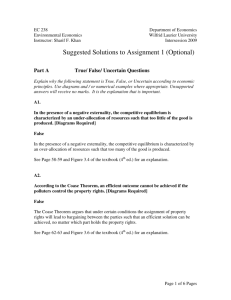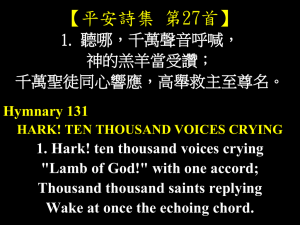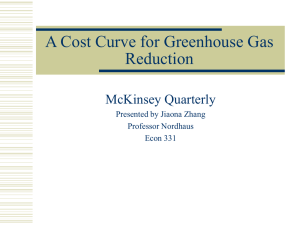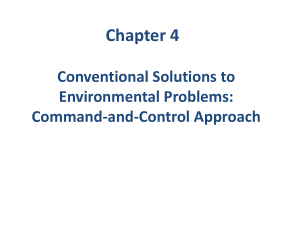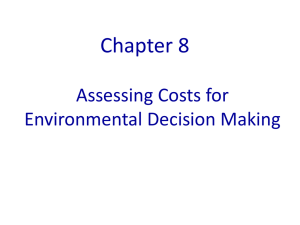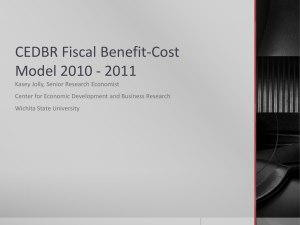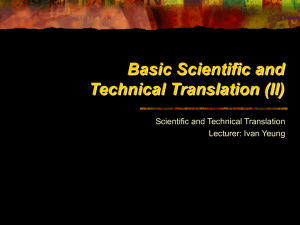ECO 324
advertisement
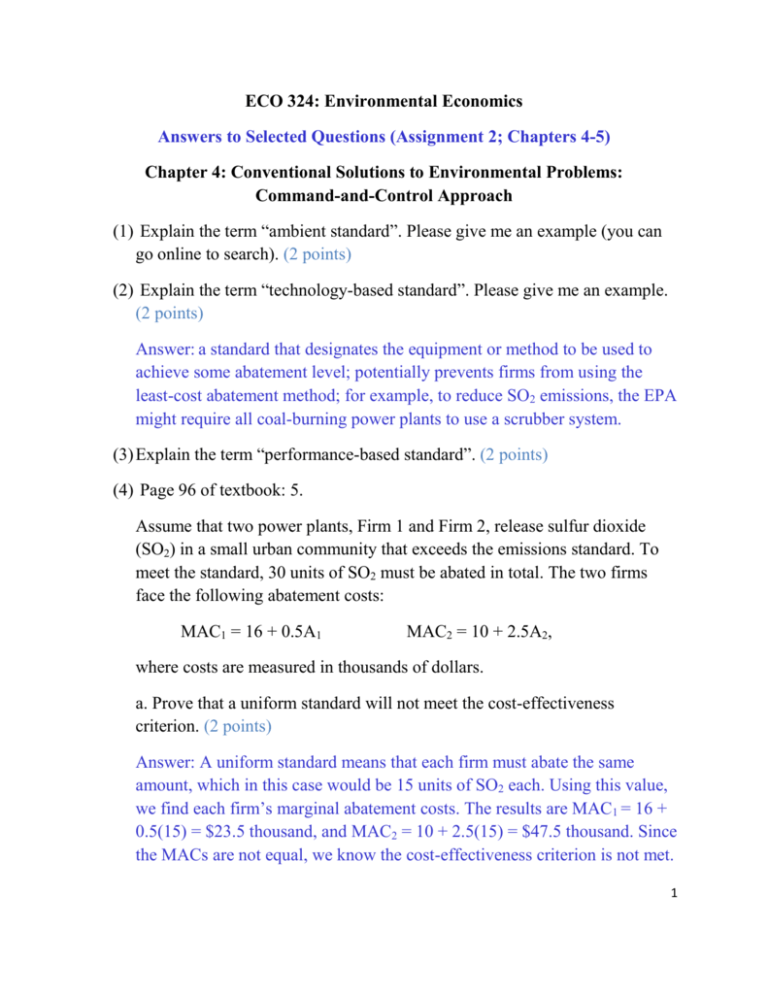
ECO 324: Environmental Economics Answers to Selected Questions (Assignment 2; Chapters 4-5) Chapter 4: Conventional Solutions to Environmental Problems: Command-and-Control Approach (1) Explain the term “ambient standard”. Please give me an example (you can go online to search). (2 points) (2) Explain the term “technology-based standard”. Please give me an example. (2 points) Answer: a standard that designates the equipment or method to be used to achieve some abatement level; potentially prevents firms from using the least-cost abatement method; for example, to reduce SO2 emissions, the EPA might require all coal-burning power plants to use a scrubber system. (3) Explain the term “performance-based standard”. (2 points) (4) Page 96 of textbook: 5. Assume that two power plants, Firm 1 and Firm 2, release sulfur dioxide (SO2) in a small urban community that exceeds the emissions standard. To meet the standard, 30 units of SO2 must be abated in total. The two firms face the following abatement costs: MAC1 = 16 + 0.5A1 MAC2 = 10 + 2.5A2, where costs are measured in thousands of dollars. a. Prove that a uniform standard will not meet the cost-effectiveness criterion. (2 points) Answer: A uniform standard means that each firm must abate the same amount, which in this case would be 15 units of SO2 each. Using this value, we find each firm’s marginal abatement costs. The results are MAC1 = 16 + 0.5(15) = $23.5 thousand, and MAC2 = 10 + 2.5(15) = $47.5 thousand. Since the MACs are not equal, we know the cost-effectiveness criterion is not met. 1 b. Determine how the abatement levels should be reallocated across the two firms to minimize costs. (2 points) Answer: To achieve cost-effectiveness, the abatement requirements per firm must be reallocated so that the MACs are equal, subject to the sum of the two abatement levels, A1 + A2, equaling 30 units. This is found as follows: Cost-effectiveness requires: MAC1 = MAC2 16 + 0.5A1 = 10 + 2.5A2 Abatement standard requires: A1 + A2 = 30 Solving simultaneously: 16 + 0.5(30 – A2) = 10 + 2.5A2 31 – 0.5A2 = 10 + 2.5A2, so 3A2 = 21, Therefore: or A2 = 7, and A1 = 30 – 7 = 23 Check your result by finding MAC1 and MAC2 evaluated at the abatement levels found, and make sure they are equal. In this case, MAC1 = 16 + 0.5(23) = $27.5 thousand, and MAC2 = 10 + 2.5(7) = $27.5 thousand. Chapter 5: Economic Solutions to Environmental Problems: The Market Approach (10 points) (1) Page 122 of textbook: 1. a. b. Suppose that a chemical manufacturing plant is releasing nitrogen oxides into the air, and these emissions are associated with health and ecological damages. Economists have estimated the following marginal costs and benefits for the chemical market, where Q is monthly output in thousands of pounds and P is price per pound. MSB = 50 – 0.4Q MSC = 2 + 0.4Q MEB = 0 MEC = 0.2Q 2 a. Find the competitive equilibrium, QC and PC, and the efficient equilibrium, QE and PE. (2 points) *Hints: Competitive equilibrium arises where MPB = MPC, where MPB = MSB – MEB, and MPC = MSC – MEC. The efficient equilibrium is found by setting MSC = MSB. Answer: Competitive equilibrium arises where MPB = MPC. In this case, MPB = MSB, because MEB = 0. To find MPC, subtract the MEC from the MSC to find MPC = MSC – MEC = 2 + 0.2Q. Setting MPC equal to MPB and solving yields the following: 2 + 0.2Q = 50 – 0.4Q, so 0.6Q = 48, or QC = 80 thousand pounds. Substituting into either the MPC or the MPB to find PC: PC = 2 + 0.2(80) or 50 – 0.4(80) = $18 The efficient equilibrium is found by setting MSC = MSB and solving for QE, as follows: 2 + 0.4Q = 50 – 0.4Q, so 0.8Q = 48, or QE = 60 thousand pounds. Substituting into either the MSC or the MSB to find PE: PE = 2 + 0.4(60) or 50 – 0.4(60) = $26 b. Find the dollar value of a product charge that would achieve an efficient solution. (1 point) *Hint: A product charge that achieves efficiency would be modeled as a Pigouvian tax. This is the dollar value of the MEC at QE. That is, Pigouvian tax = MEC = 0.2QE 3 Answer: At QE, MEC in this case equals 0.2 (60) = $12, which would be the value of a product charge that generates an efficient equilibrium. (2) Page 122 of textbook: 3. a. b. c. In 1996, Michigan launched a voluntary emissions trading program, which allows polluters to achieve cost-effective solutions when meeting requirements of the U.S. Clean Air Act. (For more on this program, visit http://www.michigan.gov/deq, and click on Air, Assessment and Planning, and Emissions Trading.) Suppose that Michigan’s objective for two major firms in an urban area is a 16 percent reduction in carbon monoxide (CO) emissions and that each firm faces the following costs: Firm 1: TAC1 = 1000 + 2.5(A1)2 MAC1 = 5A1 Firm 2: TAC2 = 500 + 1.5(A2)2 MAC2 = 3A2 where A1 and A2 represent the percentages of CO emission abatement achieved by firm 1 and 2, respectively, and TAC and MAC are measured in thousands of dollars. a. Calculate the TAC and MAC for each firm if a uniform abatement standard were used. (2 points) *Hint: Based on a uniform standard, A1 = A2 = 8 percent. Answer: Based on a uniform standard, A1 = A2 = 8 percent. Therefore, MAC1 = 5(8) = $40 thousand, TAC1 = 1000+ 2.5(8)2 = $1160 thousand, MAC2 = 3(8) = $24 thousand, and TAC2 = 500+ 1.5(8)2 = $596 thousand. b. Based on your answer to part a, is there an economic incentive for the sources to participate in the trading program? Explain. (2 point) *Hint: You also need to mention which firm should abate less (will buy permits), and which firm should abate more (will sell permits). 4 Answer: With a uniform abatement standard, the MACs are unequal, which means that the abatement allocation is not cost-effective. This in turn means that each firm could realize cost savings by changing this allocation through participation in the trading program. Based on the relative dollar values of the MACs, Firm 1 should abate less, and Firm 2 should abate more, since Firm 2 is capable of abating more cheaply than Firm 1 at the margin. c. Quantify the cost savings associated with a cost-effective abatement allocation that could be achieved through trading. (3 points) *Hints: First, find the cost-effective solution (set MAC1= MAC2, then solve for A1 and A2). Second, calculate each firm’s total abatement costs based on the cost-effective allocation. Finally, determine the cost savings by comparing the sum of these TAC values to the sum under a uniform standard. Answer: First, find the cost-effective solution as follows: Cost-effectiveness requires: MAC1 = MAC2 5A1 = 3A2 Abatement standard requires: A1 + A2 = 16 Solving simultaneously: 5(16 – A2) = 3A2 Therefore: 80 – 5A2 = 3A2, so A2 = 10, and A1 = 15 – A2 = 6 To check your solution, make sure that the MACs for each firm are equal: MAC1 = 5 (6) = $30 thousand MAC2 = 3 (10) = $30 thousand Second, calculate each firm’s total abatement costs based on the costeffective allocation: TAC1 = 1000 + 2.5 (6)2 = $1,090 thousand TAC2 = 500 + 1.5(10)2 = $650 thousand 5 Finally, determine the cost savings by comparing the sum of these TAC values to the sum under a uniform standard. Combined TACs under a uniform standard = $1,160 + $596 = $1,756 thousand Combined TACs under the cost-effective solution = $1,090 + $650 = $1,740 thousand Cost savings = $1,756 – $1,740 thousand = $16 thousand 6
